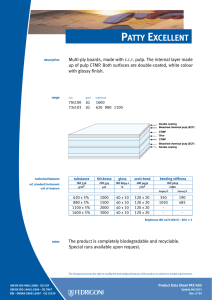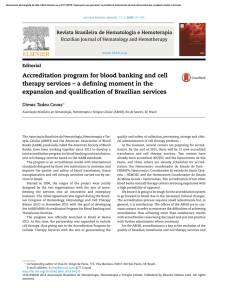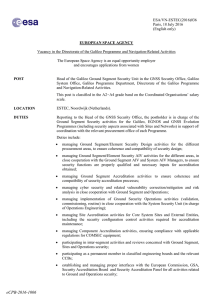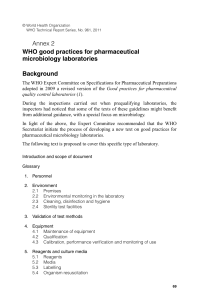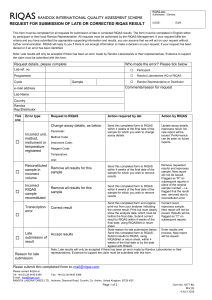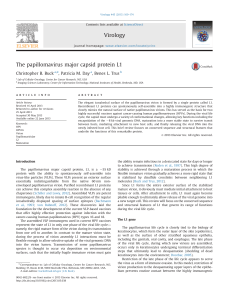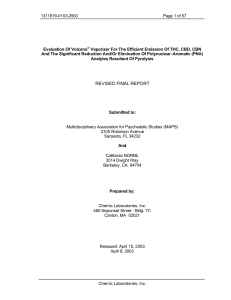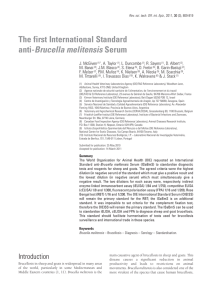Experience of implementing ISO 15189 accreditation at a
Anuncio
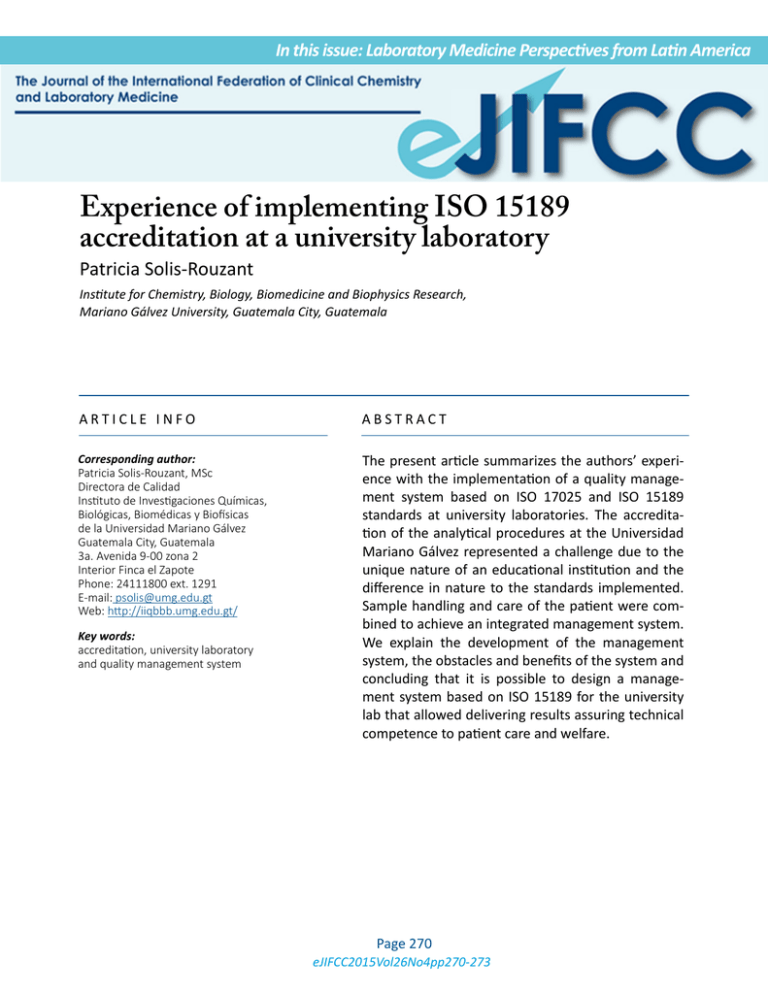
In this issue: Laboratory Medicine Perspectives from Latin America Experience of implementing ISO 15189 accreditation at a university laboratory Patricia Solis-Rouzant Institute for Chemistry, Biology, Biomedicine and Biophysics Research, Mariano Gálvez University, Guatemala City, Guatemala ARTICLE INFO ABSTRACT Corresponding author: Patricia Solis-Rouzant, MSc Directora de Calidad Instituto de Investigaciones Químicas, Biológicas, Biomédicas y Biofísicas de la Universidad Mariano Gálvez Guatemala City, Guatemala 3a. Avenida 9-00 zona 2 Interior Finca el Zapote Phone: 24111800 ext. 1291 E-mail: [email protected] Web: http://iiqbbb.umg.edu.gt/ The present article summarizes the authors’ experience with the implementation of a quality management system based on ISO 17025 and ISO 15189 standards at university laboratories. The accreditation of the analytical procedures at the Universidad Mariano Gálvez represented a challenge due to the unique nature of an educational institution and the difference in nature to the standards implemented. Sample handling and care of the patient were combined to achieve an integrated management system. We explain the development of the management system, the obstacles and benefits of the system and concluding that it is possible to design a management system based on ISO 15189 for the university lab that allowed delivering results assuring technical competence to patient care and welfare. Key words: accreditation, university laboratory and quality management system Page 270 eJIFCC2015Vol26No4pp270-273 Patricia Solis-Rouzant Experience of implementing ISO 15189 accreditation at a university laboratory INTRODUCTION Private Guatemalan universities are based on three pillars, academic, research, and private services. Among their principal areas and against the lack of any other entity that provides technical support, everyday universities are even prominently involved in services that are provided in response to national needs, as witnessed in other fields related with food safety, environmental pollution tracing ,and public health. The task is particularly daunting given the fact that government funding is limited, which makes almost impossible to cover all the public and private sector needs. Mariano Gálvez University (UMG) is a private institution established in 1966 and is now one of the largest universities in Guatemala by the number of students and institutional locations around the nation. The UMG’s Research Institute of Chemistry, Biology, Biomedics and Biophysics (I2QB3) is made up by three main areas: Chemistry Analysis (CA), Biomolecular Analysis (BA) and Clinical Analysis (ClA). Among its main activities are chemical assays in raw material, final products, pharmaceutical products, food, water and vegetable products; particularly with those that involve human samples, such as DNA analysis, genotyping and viral detection, clinical chemistry, immunology, coprology, urology, hematology and bacteriology. Furthermore, the research institute has laboratories equipped for basic laboratory practices linked to career courses provided by UMG. Unlike private commercial laboratories, I2QB3 laboratories own the latest generation of instrumentation, and this is not the case in other university laboratories due to financial limitations and complex maintenance requirements. Another advantage for I2QB3 is the availability of highly qualified personnel and university support. The performance of the I2QB3 depends on policy formed by other university bodies which are in charge of personnel, accounting, technical support and management. MATERIAL AND METHODS a. Implementation of an integrated quality system at university laboratories Technical directors at each laboratory began to imply quality assurance from the year 2007, two years after I2QB3 was inaugurated. After facing multitude of difficulties with the accreditation of several analytical procedures, when accreditation was granted in 2012. The selected analytical procedures were distributed between CA and BA, implying that the nature and function of the procedures made it necessary for implementation of an integrated quality system that included ISO 17025 and ISO 15189 requirements. The challenge of an integrated system in a complex environment such as the university laboratory required hiring consulting services in 2008, which included training and advising in the construction of the quality system. The limited time allotted by the university board led to the recognition for the need to hire personnel to maintain the timely implementation of the management system. A Quality Coordinator was hired and the former Director of CA became the Quality Director. In order to avoid a conflict of interests, The Quality Directorship was created independently from all laboratories. b. ISO 15189 Component The I2QB3 started the accreditation process based on ISO 15189 with two molecular biology techniques: • Genotyping of 37 human papillomavirus genotypes (HPV); and • Human papillomavirus genotypes detection of high and low risk. Page 271 eJIFCC2015Vol26No4pp270-273 Patricia Solis-Rouzant Experience of implementing ISO 15189 accreditation at a university laboratory The decision to start with the analysis of human papillomavirus detection came from the General Director´s vision to provide to Guatemalan physicians the latest generation of tools for preventing and detecting cervical cancer. These tests combined with the Papanicolaou staining contributed to diminishing the disease and according to the Pan-American Health Organization (PAHO) was the number one cause of death in Guatemalan women, for both indigenous and rural populations1, 2. To cover all the needs of medical interactions, pharmaceutical entities and patients, a scientific advisor was hired whose main role was to provide consulting for the best choice of services offered by the I2QB3. Personnel responsible for the performance of the analyses were hired mainly for the aforementioned aim and with the additional tasks that included research and academic support. The analyses listed in the accreditation process were highly specific and those were not performed in any other laboratory in Guatemala; thus, the technical staff developed proficiency skills in parallel with the development and verification of the methods. RESULTS During the quality system implementation, the re-modeling of the buildings to improve the customer service started, to improve the reception and collection of the sample by health professionals trained for this task, but also physicians were included. One of the greatest challenges was the low volume of samples, which hindered the monitoring and corrective actions procedures. Another challenge was import and access to reagents, equipment and technical support in Guatemala. The fact that the I2QB3 performs unique assays in the country causes the I2QB3 to get just one provider in terms of equipment, reagents and technical support: at times, the services were not as effective as one would expect; this was also true for the leading corporations in the world. More recently, besides at UMG, there are only two entities accredited under the ISO 15189 standard, and both are private hospital laboratories. For this reason, the users (physicians, patients and regulatory entities) of services from clinical laboratories, utilizing ISO 15189 practices are still in the process of establishing the value of the quality and understanding the benefits of the usage of accredited services. In addition of the challenge of communicating and making the population understand the value of the quality management system, the users had to get used to accepting and respecting the terms and conditions of accredited laboratories. The requirements in the analyses demands, the sample handling and the information & results formats. Situations in the beginning of the quality system management implementation process that were more difficult to get accepted by the customers were those involving the terms and conditions. During the years since the accreditation was obtained and with continuous improvements that facilitated the development of new technologies around the world, which are based on the development of the references materials for the human papillomavirus genotype 16 and 18 by the National Institute for Biological Standards and Control (NBSC) in collaboration with the World Health Organization (WHO)3. Furthermore, the availability of the proficiency testing assays from the American Pathology College (CAP) allowed for improving the mechanisms to assure the quality of results4. In 2013, the transition to ISO 15189 published in 2012 was performed. At this point, counting on an integrated management system turned out to be a good advantage that facilitated the Page 272 eJIFCC2015Vol26No4pp270-273 Patricia Solis-Rouzant Experience of implementing ISO 15189 accreditation at a university laboratory transition. Some requirements and documented procedures of the new ISO 15189 version were already considered a part of the ISO 17025. procedures, and as such forwarding the care and wellbeing back to the patient. REFERENCES CONCLUSIONS The experience of the accreditation process under the ISO 15189, for the first university laboratory and for the accredited Guatemalan organization under two standards within an integrated quality management system, confirmed the benefits and is now counted on as a quality management system in laboratories for the improvement of the efficiency and effectiveness of analysis processes. Despites the difficulties that Guatemala comes across to offer services of international quality, it is possible to design a quality management system that allows delivery to patient of their results of analyses with the warranty and technical proficiency of the 1. Arrossi, S., Sankaranarayanan, R., & Parkin, D. M. (2003). Incidence and mortality of cervical cancer in Latin America. Salud Pública de México, 45(3), 306-314. 2. World Health Organization. (2015). Guatemala: Prevención y tratamiento del cáncer del cuello uterino. Retrieved from: http://www.paho.org/esp/index.php?option= com_content&view=article&id=671:guatemala-prevencion-y-tratamiento-del-ca%C2%A1ncer-del-cuellouterino&Itemid=497, 2015. 3. National Institute for Biological Standards and Control. (2015). Retrieved from 1st WHO International Standard for Human Papillomavirus (HPV): http://www.nibsc.org/documents/ifu/06-202.pdf, 2015. 4. Zapata-García , D., Llauradó, M., & Rauret, G. (2007). Experience of implementing ISO 17025 for the accreditation of a university testing laboratory. Accreditation and Quality Assurance, 12(6), págs. 317-322. Page 273 eJIFCC2015Vol26No4pp270-273

